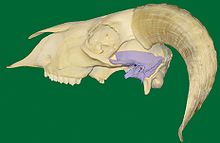Structure and Development of the Temporomandibular Joint
- Joint capsule
- Articular disc
- Mandibular condyles
- Articular surface of the temporal bone
- Temporomandibular ligament
- Capsule is a thin, loose envelope attached to mandibular fossa and articular tubercle
- Articular disc is composed of dense fibrocartilagenous tissue and divides the joint into upper and lower compartments
- Ligaments include the temporomandibular ligament, stylomandibular ligament, and sphenomandibular ligament
- Joint formation begins around 12 weeks of gestation
- Mesenchyme forms the fibrous joint capsule
- The developing lateral pterygoid muscle attaches to the fetal disc
- The disc extends posteriorly through the petrotympanic fissure and attaches to the middle ear
- The mandibular condyle has a growth center with hyaline cartilage that allows for bone growth
Function and Jaw Movement of the Temporomandibular Joint
- Temporomandibular joint is a ginglymoarthrodial joint, combining hinging and sliding movements
- Mandibular condyle articulates with the temporal bone in the mandibular fossa
- An articular disc divides the joint into two compartments
- Rotation occurs in the lower compartment, while translation occurs in the upper compartment
- Resting position of the joint allows for a 2-4mm interocclusal clearance
- Normal full jaw opening is 40-50 millimeters
- Mandible moves during jaw movements, not the maxilla
- Excursions include lateral movements, forward (protrusion), and backward (retrusion) movements
- Protrusion involves translation of the condyle without significant rotation
Clinical Significance and Pathologic Conditions of the Temporomandibular Joint
- Temporomandibular joint pain can be caused by myofascial pain dysfunction syndrome
- Internal derangements, such as disc displacement, can also cause pain
- Osteoarthritis is a degenerative joint disease affecting the temporomandibular joint
- Temporal arteritis can cause pain and is considered a diagnostic criteria
- Temporomandibular joint dysfunction (TMD) refers to a group of problems affecting the joint and associated tissues
- Chondrosarcoma and osteosarcoma are rare conditions that can affect temporomandibular joint function
- Other conditions may cause pain and swelling in the joint
- Proper diagnosis and treatment are essential for managing these pathologic conditions
- Regular dental and medical check-ups can help detect and address any issues with the temporomandibular joint
Examination and Disc Displacement in the Temporomandibular Joint
- Temporomandibular joints can be felt in front of or within the external acoustic meatus during mandibular movements
- Auscultation of the joint can be performed
- The most common disorder of a temporomandibular joint is disc displacement
- Disc displacement occurs when the articular disc moves out from between the condyle and the fossa
- Disc displacement is usually very painful
- The articular disc is attached anteriorly to the superior head of the lateral pterygoid muscle and posteriorly to the retrodiscal tissue
- Disc displacement causes the mandible and temporal bone to make contact on something other than the articular disc
- In most instances of disc displacement, the disc is displaced anteriorly upon translation
- Disc displacement with reduction is characterised by a pop or click sound upon opening and closing of the mouth
Temporomandibular Disorder (TMD) and Fibromyalgia
- TMD is pain and dysfunction of the TMJ and the muscles of mastication
- TMD represents a range of distinct disorders with multifactorial etiology
- TMD is the second most frequent cause of orofacial pain after dental pain
- The pathophysiology of TMD is poorly understood
- TMD accounts for the majority of pathology of the TMJ
- Fibromyalgia is a condition associated with TMD
- Fibromyalgia is characterised by widespread musculoskeletal pain and fatigue
- Fibromyalgia is more common in women than in men
- The exact cause of fibromyalgia is unknown
- Fibromyalgia often coexists with other chronic pain conditions
In anatomy, the temporomandibular joints (TMJ) are the two joints connecting the jawbone to the skull. It is a bilateral synovial articulation between the temporal bone of the skull above and the mandible below; it is from these bones that its name is derived. This joint is unique in that it is a bilateral joint that functions as one unit. Since the TMJ is connected to the mandible, the right and left joints must function together and therefore are not independent of each other.
| Temporomandibular joint | |
|---|---|
 | |
 The joint seen from the inner surface. | |
| Details | |
| Artery | Superficial temporal artery |
| Nerve | Auriculotemporal nerve, masseteric nerve |
| Identifiers | |
| Latin | Articulatio temporomandibularis |
| Acronym(s) | TMJ |
| MeSH | D013704 |
| TA98 | A03.1.07.001 |
| TA2 | 1622 |
| FMA | 54832 |
| Anatomical terminology | |

temporomandibular joint (plural temporomandibular joints)